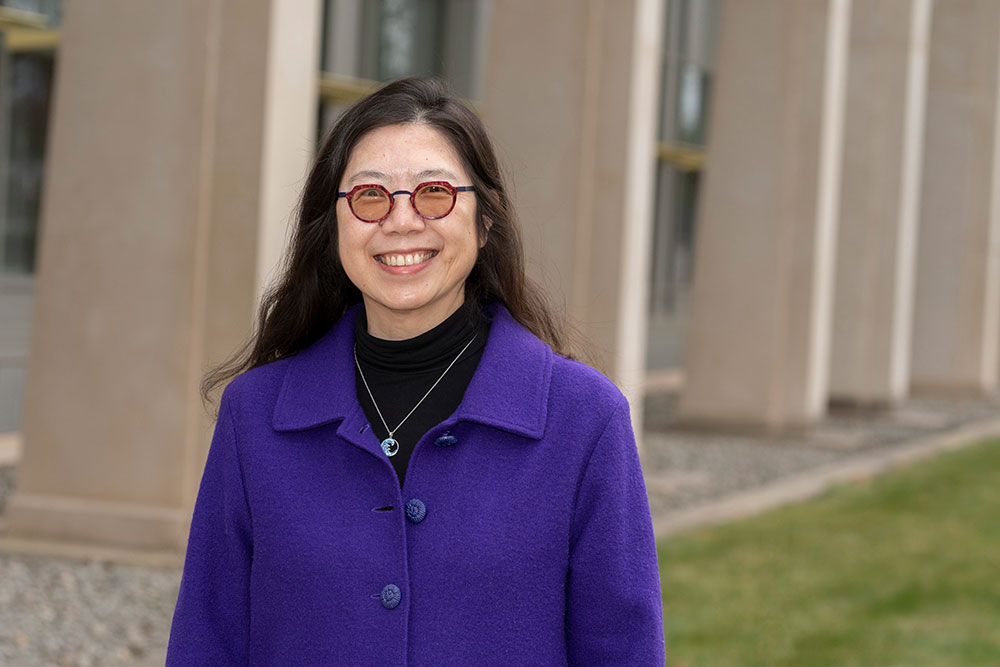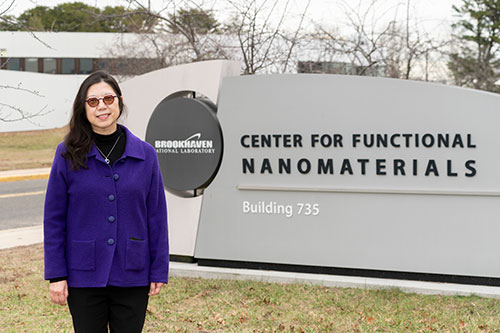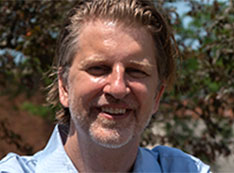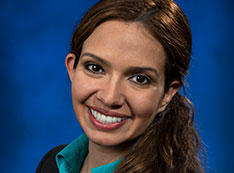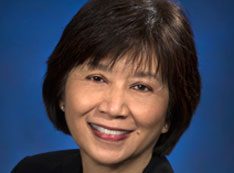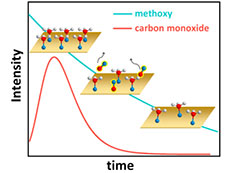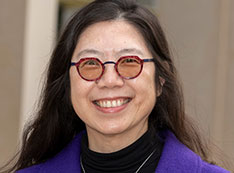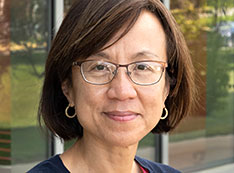Leading Electron Microscopy and Diversity Efforts at Brookhaven Lab with Judy Yang
interview with a CFN Group Leader
January 25, 2023
In September of 2022, Judith Yang joined the Center for Functional Nanomaterials (CFN)—a U.S. Department of Energy (DOE) Office of Science User Facility at Brookhaven National Laboratory—as the leader of the Electron Microscopy group. Yang has an impressive background in microscopy-based surface science studies and is also committed to advocating for increased leadership roles for women and minorities in science. She has a Ph.D. in physics from Cornell University and, prior to accepting her role at CFN, was a program director for the National Science Foundation’s Division of Materials Research and held a tenured position as the William Kepler Whiteford Professor at the University of Pittsburgh.
You were a CFN user before you became a CFN group leader. Tell us more about your background.
I grew up in the San Francisco Bay area and went to the University of California at Berkeley, where I majored in physics, and then to Cornell University where I earned my PhD in physics. My advisor at Cornell was a materials scientist and that is where I learned electron microscopy, including my thesis work, which was on metal-ceramic interfacial reactions to improve the mechanical properties of composite materials that contain both metals and ceramics.
After Cornell I accepted a postdoc position at the Max Planck Institute fuer Metallforschung in Stuttgart, Germany, which was supported by a National Science Foundation (NSF) International Postdoctoral Fellowship. During that time, I studied the effects of reactive elements on high-temperature corrosion coatings for alloys with analytical electron microscopy. I then returned to the U.S. for a second postdoc at the University of Illinois at Urbana-Champaign, where I used an in situ electron microscopy using a specially modified transmission electron microscope (TEM) for ultra-high vacuum and gas reactions. I was then hired by the University of Pittsburgh, as an assistant professor, and ascended through the ranks there to become a tenured professor.
From fall 2019 to fall 2022, when I joined the CFN, I was a rotator at NSF. The NSF provides a unique opportunity for professors to serve their community as program directors by shepherding the review process, making funding decisions, influencing the direction of science programs, mentoring young scientists, etc. I managed the metals and metallic nanostructures and ceramics program within the NSF Division of Materials Research (DMR).
How do you view your role as group leader?
I have a fantastic group of five scientists in the Electron Microscopy (EM) group, one per instrument, and they really run the show. I see my role as the facilitator. I’m a conduit between the users, staff, and facility management. As an example, I advise researchers on what might be the best possible tools for them to use and the best possible experiments for them in terms of the nanoscience they want to accomplish and link them with the appropriate scientific staff.
I am adapting to being a group leader, so I am focused on the management aspects of the job currently. For example, there are two new unique microscopes coming to the CFN and we are preparing the facility to be ready for those sensitive instruments. The first microscope is a low-energy instrument that is good for materials with low atomic numbers, such as 2-D materials, quantum materials, and polymers. The second microscope, which I’m particularly excited about, is a first-of-its-kind ultra-high vacuum environmental scanning transmission electron microscope that bridges nine orders of magnitude of gas pressure. Being able to control the gas environment allows one to bridge from well-controlled experiments needed for coupling with theory and advancing fundamental understanding to near real-world conditions for real-world applications. We are also planning on expanding the scientific staff in this group, and so I’m working with HR to start this process. I am very excited by these developments.
Additionally, there have been a lot of changes that have occurred in the last few years in terms of science and society—the pandemic played a big part in that—and I’m also focused on those new priorities.
How has the pandemic influenced your approach to being a group leader?
At this point in the pandemic we are in a hybrid situation. We are adapting again to in-person work, but we are also continuing this virtual world as well. To that end, there are exciting opportunities for remote outreach and education that have been started and we want to build up. For example, we have been developing a remote program with the University of Puerto Rico.
Another critical opportunity is the development of digital infrastructure that accommodates remote science and outreach and accelerates nanoscience and innovation; that is something I want to pursue at the CFN.
In a more general sense, the pandemic also demonstrates society’s need for science, technology, and innovation. The development of the COVID-19 vaccine is one example. The rising costs of living and inflation, such as the increase in gas and fuel prices, are also serious problems that society needs to solve for creating sustainable clean energy and combating climate change. There is a need for fundamental science, but there is also a need to broaden communication of fundamental science. Part of my training in the Executive Leadership in Academic Technology, Engineering, and Science (ELATES) program, which I participated in while at the University of Pittsburgh, was to practice talking about science to people who are not in your scientific community, and how to get beyond using science jargon when explaining your work. When people ask what I do, I say that I study rust at the atomic scale. Societal appreciation of science and more people going into the STEM (science, technology, engineering, and mathematics) fields are both important.
What prompted you to decide to come to CFN, and what do you think are the advantages of working at a national laboratory?
Each of the DOE Nanoscale Science Research Centers (NSRCs) has its own personality and identity, each with different tools and focuses. CFN emphasizes research within well-controlled environmental conditions, such as gas environments. Controlling the environment around your samples and avoiding impurities is critical. As an example, when studying corrosion and oxidation, trace amounts of impurities in the sample or in the gas can dramatically alter what type of oxide forms on the surface. There is a focus on oxidation, corrosion, catalysis, clean energy, and surface science (at the CFN). These studies are a very nice match with my background in early-stage metal oxidation, heterogeneous catalysis, and nanomaterials by primarily in situ environmental transmission electron microscopy.
CFN’s microscopy capabilities do distinguish it from the other NSRCs. Other nanocenters house environmental TEMs, but we have a multi-modal approach to those experiments, including environmental synchrotron and surface science tools, that set us apart. One of the new microscopes will be able to offer scientists a large range of pressure options, which will open up many new opportunities, such as studying semiconductors that are highly sensitive to impurities, and supporting surface science studies that require ultra-high vacuum.
Another example is a new project with the University of Michigan to look at “III-V” (three-five) nanowires, which are nanowires composed of semiconductor alloys from the III and V groups of the periodic table, and determine what factors control the alloy selection and atomic structure. To do this type of experiment, we need to examine the dynamics of how these nanowires nucleate and form at the atomic scale in real-time using atomic-level characterization tools with exceptional control of the gas and temperature environment.
During my time at NSF, I began thinking about service to society through science. If you want to be at the leading edge of science and technology and innovation, you need leading infrastructure. And the places that are (arguably) doing that the best are the national laboratories, especially the DOE Office of Science User Facilities, such as the CFN. They provide the nation (and internationally too) with cutting-edge equipment and infrastructure for science coupled with expert scientific staff.
The other thing that drew me to CFN besides the infrastructure development, that includes digital infrastructure and data sharing, is the lab’s focus on DEIA: diversity, equity, inclusion, and accessibility.
You are interested in fostering leadership for women and minorities, and promoting diversity, in STEM fields. Tell us more about your support for DEIA.
I am very committed to these efforts. I participated in ELATES in 2015/2016, which is a national program designed to promote women in academic STEM fields into leadership roles within their schools and universities.
I was also on the University of Pittsburgh’s provost’s advisory committee for women’s concerns, which is a three-year rotation. Additionally, I was the chair of the School of Engineering diversity advisory committee, which also placed me on the university’s internal advisory committee for the NSF Alliances for Graduate Education and the Professoriate (AGEP) program. AGEP is a network of universities that have committed to helping underrepresented minorities obtain graduate degrees in STEM fields.
Being part of the ELATES program made me think about leadership beyond doing only science. Getting to know other impressive women faculty who aspired to and are in academic leadership was great; it was transformative and changed the direction of my career. My institutional project (for ELATE) was the Environmental TEM (ETEM) Catalysis Consortium, in which the University of Pittsburgh is a gateway to other shared user facilities, including the CFN. The goal was to help people develop their research in catalysis at this gateway site with modern instruments, including the ETEM, for initial results. Then, they could better demonstrate the feasibility and need in their user proposal at a shared user facility for a successful user proposal and carry out their well-defined experiment successfully with the cutting-edge instruments at these shared user facilities.
How can CFN and Brookhaven continue to improve DEIA efforts?
A national lab has the incredible ability to reach out and improve DEIA across the U.S. in ways that other institutions might not be able to; there has been an increasingly significant realization of this need.
I think we should focus on extending the reach of our remote infrastructure, such as our partnership with the University of Puerto Rico at the Rio Piedras and Mayagüez campuses. Not every institution can have an electron microscope, and we can train people remotely on electron microscopy. We are also building a partnership with some investigators in Africa. The EM staff has provided long-term support to a group whose members received their initial higher education while residing in Nigeria, including Dr. Ericmoore Jossou and, more recently, Dr. Ahmed Tiamiyu (both are currently with the University of Saskatchewan in Canada).
We will reach out to historically black colleges and universities (HBCUs) and minority-serving institutions (MSIs) to engage in two-way conversations and explain how we are able to meaningfully interact with them with the resources at our shared user facilities for education, training, and research, which includes grant proposals. There are also other modes of engaging with MSIs; a specific example is the NSF Partnerships for Research and Education in Materials (PREM) program, which supports research and education opportunities between MSIs and centers and/or facilities (supported by NSF DMR) to increase recruitment and degrees earned by those underrepresented in materials research.
We also could tap into the DOE Reaching a New Energy Sciences Workforce (RENEW) program, which aims to increase partnerships between the DOE Office of Science (SC) and institutions that have been historically underrepresented in the SC research portfolio. RENEW offers many funding opportunities.
The main goal is to communicate more with MSIs. We also need better statistics to guide us: it would be important to know the users and their institutions, identify those underrepresented in nanoscience, and understand what their needs are. We can also broadcast widely our funding opportunities to support them, including students, such as the Science Undergraduate Laboratory Internship (SULI) program and other internship programs, that enriches their research experience too.
Why do you think that more researchers should consider becoming CFN users?
I was a very happy CFN user who took advantage of its unique electron microscopy and surface science tools, especially for the in situ characterization of the early stages of alloy oxidation. I really enjoyed it, especially because of the great combination of exceptional tools and the excellent and very helpful scientific staff. While a faculty member at the University of Pittsburgh, I and a couple of graduate students or post-docs in my group would go to the CFN for one or two weeks. It was extremely helpful to them for their research, science education, and training; I relished being able to perform high-end science. I think more researchers should experience this. And (if they are willing to publish their results), it’s free!
Brookhaven National Laboratory is supported by the U.S. Department of Energy’s Office of Science. The Office of Science is the single largest supporter of basic research in the physical sciences in the United States and is working to address some of the most pressing challenges of our time. For more information, visit https://energy.gov/science.
2023-21064 | INT/EXT | Newsroom




